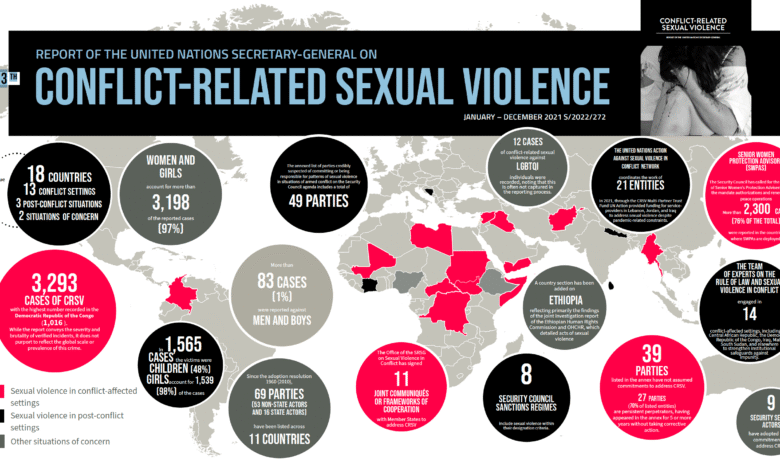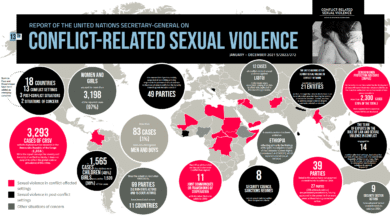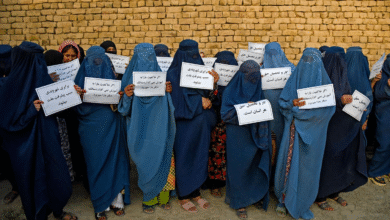Conflict-Related Sexual Violence: Urgent Calls for Action

Conflict-related sexual violence (CRSV) represents one of the most harrowing aspects of armed conflict, profoundly affecting the lives of countless individuals, particularly women and children. As highlighted in recent sexual violence statistics, there was a staggering 25 percent increase in reported cases of CRSV in 2024, a figure that experts believe significantly understates the reality on the ground. Special Representative Pramila Patten emphasized this reality during the Security Council’s open debate, where she called for urgent support for survivors amid plummeting resources for vital services. Unfortunately, as UN peacekeeping funding dwindles, those seeking assistance face increasingly dire situations, especially in conflict zones like the Central African Republic and South Sudan. Addressing the issue of CRSV is critical not only for humanitarian reasons but also for restoring peace and security in affected regions.
The term sexual violence in armed conflict encompasses the various atrocities faced by individuals during warfare, highlighting the urgent need for intervention and support. As the international community grapples with escalating rates of these violations, it becomes imperative to examine how armed conflict disproportionately impacts vulnerable populations, particularly women and girls. By encouraging a broader discussion about the plight of survivors and the alarming rise in instances of sexual abuse in conflict zones, we can promote understanding and foster action. Furthermore, initiatives aimed at bolstering support for rape victims and enhancing the efficacy of peacekeeping missions are critical for establishing long-term stability. Fostering awareness around this issue is essential for ensuring accountability and protecting the rights of those impacted.
The Rise of Conflict-Related Sexual Violence
Recent statistics reveal a troubling trend in conflict-related sexual violence (CRSV), showing a staggering 25 percent increase from the previous year. In 2024 alone, over 4,600 cases were reported, yet these numbers likely represent only a fraction of the actual incidents, as they rely on UN verification. This escalation in violence highlights the urgent need for international attention and effective intervention, particularly in regions like Central African Republic and Democratic Republic of the Congo, where CRSV is rampant.
Moreover, the sexual violence statistics indicate a significant rise in attacks against vulnerable populations, particularly children, underscoring the horrors of CRSV. Disturbingly, data shows a 35 percent increase in sexual violence against minors, with cases involving victims as young as one year old. Given the complex interplay between armed conflict and gender-based violence, it is crucial for global leaders to recognize these trends and address the underlying causes of CRSV to protect those at risk.
Support for Survivors in Conflict Zones
The ongoing crisis surrounding conflict-related sexual violence necessitates robust support systems for survivors. As outlined by the Special Representative on Sexual Violence in Conflict, Pramila Patten, there is an urgent requirement to implement sustainable services for victims, especially in conflict-affected regions where resources are dwindling. The closure of shelters and clinics due to funding cuts severely impacts the availability of medical supplies and psychosocial support needed for survivors’ recovery.
In addressing these challenges, global stakeholders must prioritize support for women’s frontline organizations which play a crucial role in aiding survivors. These organizations are often the first responders to the needs of women and girls affected by CRSV. However, without adequate funding, their capacity to assist dwindles. Advocacy for increased financial backing and resources is essential for ensuring that survivors receive necessary care and that the cycle of sexual violence is effectively challenged.
The Impact of Armed Conflict on Women and Girls
The intersection of armed conflict and sexual violence reveals a grim reality for women and girls, who are disproportionately affected by these atrocities. Reports consistently show that over 90 percent of verified cases of CRSV involve female victims. Factors such as displacement and food insecurity exacerbate their vulnerability, as humanitarian access is often restricted by warring parties, further heightening the risks they face in conflict zones.
Efforts to combat the repercussions of armed conflict on women must be multifaceted. There is a pressing need for programs aimed at protecting and empowering women amidst conflict, focusing on their rights and safety. Initiatives that incorporate women’s input in peacekeeping discussions and policies can lead to improved outcomes for long-term security and justice.
The Role of UN Peacekeeping in Addressing CRSV
UN peacekeeping missions play a vital role in addressing conflict-related sexual violence by providing protection and support to affected populations. With funding cuts leading to a reduction in peacekeeping capacities, the ability of the UN to reach and support CRSV survivors has been greatly diminished. This situation is particularly concerning in conflict hotspots where the challenges of CRSV are most pronounced.
To effectively combat CRSV, it is imperative for member states to reaffirm their commitment to funding UN peacekeeping operations. By ensuring adequate resources are available, peacekeeping missions can enhance their operational effectiveness while simultaneously deterring potential perpetrators of sexual violence. A strong, well-resourced presence is essential for fostering security and accountability in affected regions.
Funding Challenges and Their Consequences
The challenges of funding for CRSV support initiatives present a significant barrier to addressing this pressing issue. Pramila Patten highlighted how military spending often overshadows the funds allocated for CRSV mitigation, showcasing a stark contrast where substantial budgets are directed towards armed conflict rather than humanitarian assistance. This imbalance hampers efforts to provide essential services to survivors, leaving organizations understaffed and overwhelmed.
Additionally, as healthcare systems in conflict areas crumble, the consequences of underfunding intensify. Shelters are closing, medical supplies are running low, and overall support for survivors is becoming increasingly scarce. Investing in programs and organizations that combat CRSV is essential not only for empowering survivors but also for fostering long-term peace and stability in affected nations.
Legal Frameworks for the Prosecution of CRSV
Legal frameworks addressing conflict-related sexual violence are crucial for holding offenders accountable and ensuring justice for survivors. Yet, despite existing laws, many perpetrators of sexual violence in conflict go unpunished due to lack of enforcement or sufficient legal infrastructure. Strengthening legal measures and ensuring compliance is essential for creating a deterrent against CRSV.
Furthermore, current laws must be backed by adequate resources and support infrastructures to effectively aid victims in their pursuit of justice. The role of international bodies, such as the International Criminal Court, in prosecuting cases of CRSV must be emphasized, alongside initiatives that provide legal aid and support to survivors seeking justice against their perpetrators.
Community-Based Approaches to Prevent CRSV
Community-based approaches to preventing conflict-related sexual violence focus on grassroots efforts that involve local populations in identifying risks and crafting practical solutions. Engaging community leaders and members in the dialogue about sexual violence ensures that responses are appropriate and effective, considering cultural nuances and local dynamics.
Programs that promote education and awareness about CRSV play a critical role in challenging the societal norms that enable such violence. By fostering dialogue within communities and empowering local actors, sustained change can be achieved, reducing the occurrence of CRSV and building resilience among vulnerable populations.
Global Action Against Conflict-Related Sexual Violence
The global response to conflict-related sexual violence must be united and comprehensive, involving international cooperation across various sectors. Governments, non-governmental organizations, and civil society must come together to develop a multifaceted strategy that addresses both the immediate and long-term needs of survivors. Such collaboration is essential for creating an environment where survivors are supported and perpetrators are held accountable.
This united front should prioritize addressing the root causes of CRSV while also ensuring that survivors have access to necessary resources and opportunities for recovery. Through a concerted global effort, there can be a significant impact made on tackling the prevalence of sexual violence in conflict and fostering resilience among affected populations.
The Future of Peacekeeping and CRSV Mitigation
Looking ahead, the future of peacekeeping missions and their role in mitigating conflict-related sexual violence will depend largely on sustained international commitment and resources. As the demand for peacekeeping interventions increases in light of escalating conflicts, so too does the necessity for funding to support these operations effectively.
Innovative approaches to funding and strategic partnerships are essential for shaping the future landscape of CRSV mitigation. By investing in technology, data collection, and survivor-focused programs, the international community can respond to the evolving challenges of sexual violence in conflict and remain committed to safeguarding the rights and dignity of all individuals.
Frequently Asked Questions
What is conflict-related sexual violence (CRSV) and why is it a concern?
Conflict-related sexual violence (CRSV) refers to acts of sexual violence committed in a context of armed conflict. It is a pressing concern because it disproportionately affects women and girls, accounting for over 90% of verified cases, and significantly impacts their safety and well-being. Reports have shown a staggering rise in reported cases, with over 4,600 instances in 2024 alone, underscoring the critical need for intervention.
How do sexual violence statistics reflect the severity of conflict-related sexual violence threats?
Sexual violence statistics provide an essential insight into the escalating issue of CRSV. For instance, the recent report highlighted a 25% increase in reported cases, as well as a concerning 35% rise in violence against children, indicating that such acts are rampant in conflict zones. These statistics are often an undercount, reliant on verified cases, demonstrating that the actual figures may be even higher and more alarming.
What forms of support for survivors of conflict-related sexual violence are available?
Support for survivors of conflict-related sexual violence includes medical care, psychological support, and legal assistance. Organizations like UN Action Against Sexual Violence in Conflict work to enhance service delivery and reach survivors in various conflict areas. However, funding cuts have severely hampered these efforts, leading to a shortage of necessary services and shelters for survivors.
How does armed conflict and women relate to the issue of conflict-related sexual violence?
The relationship between armed conflict and women is critical, as armed conflicts often exacerbate gender-based violence, particularly CRSV. Women and girls face heightened risks during conflicts, especially in displacement scenarios where their safety is compromised. Understanding this link is vital for developing tailored interventions to protect and support women in these situations.
How does UN peacekeeping funding impact the response to conflict-related sexual violence?
UN peacekeeping funding is essential for maintaining operations that address conflict-related sexual violence. Recent cuts in funding have decreased the capacity of UN missions to reach and support CRSV survivors effectively, leading to an increased danger for women and girls and diminished support services, such as shelters and medical care.
What are the key trends identified in the rise of conflict-related sexual violence?
Key trends in the rise of conflict-related sexual violence include the increasing targeting of women and girls, the high rates of violence against children, and the use of sexual violence as a tactic by armed groups to exert control. Moreover, issues such as food insecurity and humanitarian access restrictions are compounding the risks for vulnerable populations in conflict zones.
| Key Points |
|---|
| Security Council’s open debate on conflict-related sexual violence (CRSV) led by Pramila Patten, highlighting an increase in violence and decrease in resources. |
| 4,600 reported cases of CRSV in 2024, a 25% increase from 2023; undercounted data. |
| 35% increase in sexual violence against children, with victims as young as one year old. |
| High incidence of CRSV in Central African Republic, DRC, Haiti, Somalia, and South Sudan. |
| Women and girls account for over 90% of verified cases, highlighting the gendered nature of CRSV. |
| Displaced women face increased risks of sexual violence; food insecurity exacerbates the situation. |
| UN funding cuts lead to reduced capacity for supporting survivors and closing shelters. |
| Urgent need for more funding to support institutions addressing CRSV to combat impunity. |
| Ms. Patten’s three-pronged action plan: compliance, service delivery, and safeguarding against impunity. |
Summary
Conflict-related sexual violence (CRSV) continues to be a pressing global issue, reflecting rising military conflicts while resources to combat this violence are dwindling. The alarming reports from the Security Council underline the urgent need for increased support for survivors and stronger accountability measures against perpetrators. With a significant rise in cases of CRSV and disturbing trends in the victimization of women and children, it is critical for international communities to prioritize funding and strategies that can effectively address and prevent this grave violation of human rights.




